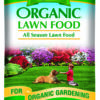Imagine stepping outside into your garden, the Florida sun is shining, and there, amidst the vibrant greens and florals, your furry companion is frolicking safely. This is not just a dream; it’s a reality you can create with a little know-how and dedication to making your garden a pet-safe haven. Whether you’re a seasoned gardener or just starting out, the key is to plan with your pet in mind.
Key Takeaways
- Identify pet-safe plants that thrive in Florida’s climate, like Boston ferns and marigolds.
- Design garden paths with soft materials to protect your pet’s paws from the heat.
- Provide ample shade and water features to keep your pets cool in the summer heat.
- Choose non-toxic fertilizers and pesticides to maintain a pet-safe environment.
- Integrate pet shelters into your garden landscape for a cozy retreat.

“Florida – Palm Beach – Pan’s Garden …” from www.flickr.com and used with no modifications.
Cultivating Your Haven: Florida Pet Safe Gardens
Defining Florida-Friendly and Pet Safe
When we talk about Florida-friendly gardening, we’re referring to landscapes that conserve water, protect the environment, and are easy to care for. But when we add pets into the mix, we need to think about non-toxic plants, safe fertilizers, and creating spaces that are not just beautiful but also safe for our four-legged friends to explore.
Planning Your Garden Space
Before planting a single seed, take a moment to observe your garden. Consider the areas where your pet likes to play or rest. Plan your garden layout to include these spots and work around them. This way, you’ll ensure that your garden is both aesthetically pleasing and functional for your pet’s needs.
Start by drawing a simple sketch of your garden, marking the areas that get the most sun and shade throughout the day. This will help you decide where to place pet shelters and water features, which we’ll delve into later.
Building the Foundation: Pet-Friendly Plants
Navigating Through Non-Toxic Flora
Florida’s warm climate supports a diverse range of plant life, but not all plants are safe for pets. Some common plants, while beautiful, can be toxic if ingested by our furry companions. Therefore, it’s essential to do your research or consult with a local nursery to ensure the plants you choose are non-toxic.
- Boston ferns: These lush, leafy greens are non-toxic to pets and thrive in Florida’s humidity.
- Marigolds: A colorful addition to your garden, marigolds are safe for pets and can even help repel certain pests.
- Spider plants: Known for their air-purifying qualities, spider plants are also safe for pets and easy to care for.
Remember, the goal is to create a space where you and your pet can relax without worry. By choosing pet-safe plants, you’re laying the groundwork for a garden that’s a joy for everyone.
Heat Tolerant Greens for Your Pet’s Retreat
Florida’s heat can be intense, especially in the summer months. This means it’s crucial to select plants that can withstand the heat while providing a comfortable environment for your pets. Plants like aloe vera and pet grass not only tolerate the heat but also offer health benefits for your pets. Aloe vera can soothe minor skin irritations, while pet grass can aid in digestion.
However, be cautious with aloe vera as it can be harmful if ingested in large quantities. Always supervise your pets around these plants or opt for pet grass, which is entirely safe for nibbling.
Safe Sheltering Spots Amidst Nature
Creating a garden that’s a sanctuary for your pets involves more than just plants; it’s about crafting areas where they can seek refuge from the sun and relax. Think about adding a cozy corner with a pet bed under the shade or a small, covered area where they can escape the midday heat.
Shade and Shelter: Creating Cool Zones for Pets
Shade is a pet’s best friend during the hot Florida summers. Strategically placed trees, pergolas, or even tall shrubs can provide much-needed relief from the sun. When selecting plants, choose species that grow well in your local climate and provide a thick canopy of leaves. For instance, the Southern Live Oak is not only majestic but also offers a broad shade area, perfect for your pet’s outdoor lounging.
Selecting Shade Providers
When choosing shade providers, consider both the height and spread of the plant at maturity. You want to ensure that it offers ample shade and is placed at a safe distance from your home to avoid any structural damage. Some excellent choices for Florida gardens include:
- Crape Myrtle: Known for its beautiful flowers and hardy nature.
- Banana Tree: Fast-growing and provides a tropical feel along with shade.
- Palmetto Palm: A Florida native that’s both shade-giving and pet-friendly.
Integrating Pet Houses and Retreats
Apart from natural shade, consider adding a pet house or a specially designed retreat that blends with your garden’s aesthetics. Ensure it’s made from non-toxic materials and provides proper ventilation. Elevate the house to protect your pet from ground heat and consider adding a water bowl nearby to keep them hydrated.
Safeguarding Pets in Summer Heat
The summer heat in Florida can be relentless, and it’s vital to take measures to protect your pets. Always have fresh, clean water available in multiple shaded areas. You can also create a cool-down spot by laying down wet towels for your pets to lie on. These simple steps can prevent overheating and ensure your pets enjoy the garden as much as you do.
Example: “One summer, I noticed my retriever, Max, was avoiding the garden during peak hours. By setting up a small kiddie pool in the shade, he now has a spot to cool off and can enjoy the outdoors any time of day.”
When it comes to playtime, try to schedule it during the cooler parts of the day, such as early morning or late afternoon. This will help prevent heatstroke and keep your pet’s energy levels up without the risk of overheating.
Water Features for Hydration and Play
Water features aren’t just for aesthetics; they can be a fun and refreshing way for your pets to stay cool. A shallow pond or a splash fountain can provide endless entertainment for pets who love water. Ensure that the water is clean and the design prevents any accidental deep wading, which can be dangerous for smaller pets.
For those who aren’t keen on a full water feature, consider a simple dripping hose or a sprinkler they can play in. It’s a great way to help them beat the heat while keeping them entertained.
Always supervise your pets around water to ensure their safety. Remember, not all pets can swim well, and even those who can may struggle to get out of a steep-sided water feature.
For example, “My neighbor installed a small fountain in their pet-friendly garden. Not only does it provide a tranquil sound, but their cats love to paw at the gentle stream of water, staying hydrated and cool during the heat.”
Cooling Ground Covers That Soothe Pet Paws
The ground in Florida can get scorching hot, and sensitive pet paws need protection. Opt for ground covers that are soft and cool to the touch, such as:
- Dwarf mondo grass: It’s durable and provides a soft carpet for your pets to walk on.
- Thyme: This herb not only smells great but also tolerates foot traffic and stays cool.
- Buffalo grass: A heat-tolerant grass that’s less prickly than other varieties.
Monitoring and Managing Garden Temperatures
Keep an eye on the temperature in your garden, especially during the peak heat hours. If you notice the area getting too hot, increase shaded spaces or add temporary covers like sun sails. These adjustments can significantly lower the temperature and make the garden more enjoyable for your pets.
Empowering Pet Loving Green Thumbs
As you delve into creating your pet-safe garden, remember that your efforts are making a difference in your pet’s quality of life. With each plant you choose and each feature you add, you’re building a haven that’s safe and enjoyable for your furry family member.
Combining Aesthetics with Pet Safety
Your garden should be a reflection of your style and a safe place for your pets. By choosing the right plants and materials, you can achieve both. Use colorful, non-toxic flowers to add visual interest and texture with different types of foliage that are safe for pets to sniff and brush against.
Innovative Ideas for Pet-Friendly Gardening
Get creative with your garden design. Use raised beds to keep delicate plants out of reach, or create a designated ‘digging zone’ filled with soft soil or sand for your pets to enjoy. You can even grow a patch of catnip or a small herb garden for your pets to explore. The possibilities are endless, and with a little imagination, you can create a space that’s both beautiful and pet-friendly.
With these tips, your Florida garden will not only survive the summer heat but will become a cherished oasis for both you and your pets. Remember, the key to a successful pet-safe garden is to plan, choose the right plants and features, and always keep your pet’s safety in mind.
Combining Aesthetics with Pet Safety
Creating a pet-safe garden doesn’t mean you have to compromise on beauty. It’s all about balance and selecting elements that are non-toxic and harmonious with the natural surroundings. Think of it as crafting a living painting where every plant and feature serves a purpose, contributing to the aesthetic while ensuring the well-being of your pets.
Innovative Ideas for Pet-Friendly Gardening
Innovation is key when it comes to pet-friendly gardening. Think outside the box and consider features like a sensory garden area with a variety of textures and scents that are safe for pets. Incorporate different levels with steps or ramps for your pets to explore, and use natural barriers like rocks or dense shrubs to protect delicate plant zones.
FAQ
As you embark on this journey to create a Florida-friendly pet-safe garden, you’re bound to have questions. Here are some answers to the most common queries to help you on your way.
What plants should I avoid in my Florida pet safe garden?
While many plants are safe for pets, there are some you should definitely avoid due to their toxic nature. These include Sago Palm, Oleander, and Lilies, which can be very dangerous if ingested by your pets. Always cross-check your plant choices with a reliable list of toxic and non-toxic plants from organizations like the ASPCA.
How do I ensure my pet stays hydrated in the Florida heat?
Hydration is crucial for your pets, especially in the heat. Make sure to have multiple water stations throughout your garden, ideally in shaded areas. Consider using spill-proof bowls or even installing a pet water fountain. Regularly check the water levels and cleanliness to ensure your pets have access to fresh water at all times.
Can I use pesticides or fertilizers in my pet safe garden?
It’s best to use organic or natural alternatives to traditional pesticides and fertilizers, as many of these products contain chemicals that can be harmful to pets. Look for pet-safe labels, and consider homemade solutions like vinegar or diatomaceous earth for pest control. When it comes to fertilizers, compost or well-aged manure can be safer options for your garden.
For example, “After switching to a natural fertilizer made from composted food scraps, I noticed that my dog was more inclined to spend time in the garden, and the plants thrived just as well.”
What’s the best material for constructing a pet shelter in my garden?
When building a pet shelter, use materials that are sturdy, non-toxic, and provide insulation from the heat. Wood is a popular choice as it’s naturally insulating and can be treated with pet-safe products. Avoid metal, which can heat up quickly. Ensure the shelter is well-ventilated and placed in a shaded area.
How do I keep my pet shelter cool during the sweltering Florida summers?
Keeping your pet shelter cool is vital. Use reflective materials or paint it with light colors to reflect the sun’s rays. Consider adding a small fan or vent to increase air circulation. Planting nearby trees or shrubs can also provide additional shade and help lower the temperature inside the shelter. On extremely hot days, place a frozen water bottle or cooling mat inside for your pet to lie next to.
By following these tips and continually learning about pet-safe gardening practices, you’ll create a delightful and secure environment that both you and your pets can cherish year-round. Remember, the effort you put into your Florida-friendly pet-safe garden today will result in countless joyful moments with your furry friends in the future.
Creating a Florida-friendly pet safe garden is essential for pet owners who want to ensure their furry friends can enjoy the outdoors without any harm. As the summer heat approaches, it’s important to consider heat protection, choose appropriate landscaping, and provide adequate shelters to keep pets cool and safe.





